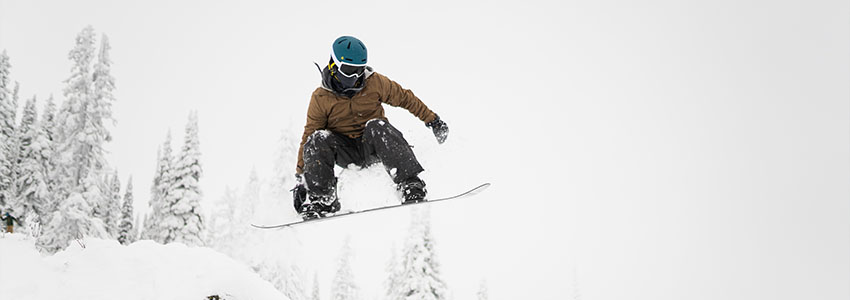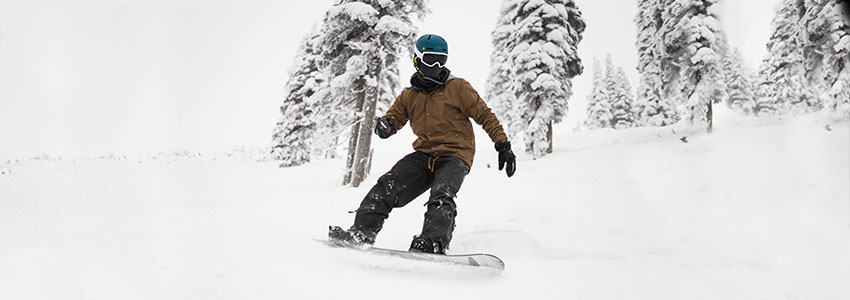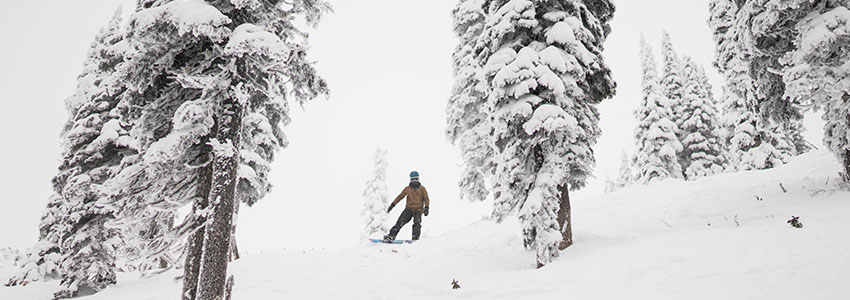How to Snowboard: Ultimate Beginner's Guide

Snowboarding is easily the best way to spend a snowy day. Cruising over the mountain terrain however you want is total freedom. If you’ve ever watched a snowboarder do their thing, you already know how easy they make it look.
But, in reality, snowboarding is nowhere as easy as it looks. Compared to skiing, snowboarding is much harder to learn, but easier to master. If you have experience with other board sports (skateboarding, wakeboarding, etc.), you’ll pick it up faster. But the basic techniques can still be tricky to get a hold on.
That’s why we put together this quick guide. So that, even if you’re a total newbie, you can still get on the hill and learn the basics of how to snowboard with ease.
How to Snowboard: A Beginner’s Guide
Before we get into the nitty-gritty, let’s lay out some basics. There are a few things to take care of before you even get to the mountain.
First, you need gear. We won’t cover this in this article, but picking the right board, snowboard boots, and bindings is crucial. Be sure to visit a local gear shop and talk to a professional so you’ve got the right kind of gear.
Next, prepare yourself mentally. Your first day on the hill can be frustrating. Be prepared to take a few falls while learning new movements and techniques. It’s all part of the process.
Last, pay attention to basic etiquette while on the mountain. If you’ve ever been to a ski resort before, you’ve probably noticed a particular kind of inexperienced rider that doesn’t pay any attention to what’s going on around them, causing problems for everyone else on the hill.
We playfully refer to these folks as “Jerrys”. Remember: you do not want to be a Jerry on the hill. Oblivious riding is dangerous for you and everybody else at the resort.
To avoid being a Jerry:
- Learn the basics and understand how to handle your snowboard before getting on the lift.
- Know where you’re supposed to be. Don’t take on runs above your ability level.
- Be mindful of others. Be careful not to cut other riders off and pay attention to what the lifties tell you when loading and unloading.
- Watch uphill. Basic Right of Way dictates that whoever is further down the hill has the right of way. But, that doesn’t mean you should be oblivious. Watch over your shoulder when traversing. In short, do whatever you can to avoid ending up in a collision.
Alright, now that we’ve got the less fun stuff out of the way, let’s get into the essentials. Here is what you need to know to go from zero to hero on a snowboard.
Strapping Into Your Board
Step one: strap into your board. When you get to the mountain on your first day, look for a flat area or somewhere with a very minor slope. Throw your board down and strap in your front foot.
Which is your front foot? Well, typically your front foot is the opposite of your dominant hand. Right handed, left footed. But not everybody feels this way, so if you start with your left foot forward and it feels “wrong,” try your right.
Unlatch the buckles and pull them out of the way. Brush the snow off the foot pad of the binding. Then, set your foot flat with your calf flat against the highback. Now, tighten it enough that your foot doesn’t wiggle when you move it.
Next, we’re going to talk about some basic techniques that involve having your back foot unstrapped. But when it’s time to strap both feet in, the process is the same for front and back.
Skating and Gliding
Once you’ve got one foot strapped into your board, it’s time to learn how to skate. Skating, in the context of snowboarding, means pushing yourself along the ground with one foot on the board. This is essential for navigating flats, but more importantly, getting on and off the chairlift.
So, your front foot is strapped into your board. Get a feel for standing on the board and make sure to bend your knees, feeling it twist as you turn, and balancing on top of it. When you’re ready, pick up your back foot and set it down close to your front foot. You can do this either in front of or behind your board. Then, push your back foot toward the back of the board and glide forward.
Once you feel comfortable balancing while skating, take your back foot and set it on your board, just in front of your back binding.
Figure out which is your front foot. Take out your back foot and stand with it either in front or behind your board. Pick your back foot up and set it down closer to your front foot, and then gently push yourself forward. Practice doing this both in front of and behind your board. And, in fact, you should practice doing this both in front, and in back of your board.
As you get more comfortable, try gliding. Skate forward, then set your back foot on your board just in front of your back binding and coast. Remember, start small. While practicing skating and gliding, stay on a flat area or a very minor slope away from other traffic.

Foot Stance and Posture
As you practice gliding, try getting into a proper snowboarding posture. Snowboarding, like many other sports, uses an “athletic stance.” This means feet in line with your shoulders with a slight bend in your knees. Practice leaning forward and back while standing on your board in an athletic stance.

Using Your Edges
By now, you’re ready to start making turns. Again, be sure to practice all these techniques on a minor slope before you get anywhere near a chairlift. Learning to use your edges on a snowboard can be frustrating. Just be patient and keep at it.
Half Turns
The first turn everybody should learn on a snowboard is the half turn or “J-turn.” To make a half-turn, skate forward and glide. Then, with your knees bent, lean back very gently and put your weight slightly forward (toward the nose of the board). This will initiate a heelside 90 degree turn, bringing you to a stop.
When doing a toeside turn, the principle is essentially the same. Once you have a feel for heelside J turns, try it toeside. You’re going to lean forward very slightly and shift your weight toward the front of the board.
This will lift your board up onto an angle, engaging your toeside edge and initiating a turn. When you come to a stop, find your balance and lean back to flat with your weight centered on the board.
Keep practicing half turns until you feel confident in your ability to stop yourself moving on a mellow slope. If you’re having trouble or falling over, remember, the angle you should be leaning and shifting your weight to is very minor. Also be careful not to fall on your wrists if you should tip over.

Traversing
The next step is learning to traverse. For this, you’re going to want to be on a slightly steeper slope. Traversing is best practiced somewhere like the bunny hill. You’re looking for a very mellow slope that’s open, with good visibility, and free of other riders.
“Traversing” just means crossing the slope sideways while descending slowly. You do this by engaging one edge and leaning uphill (either heel or toeside). Your edge will engage, and your weight will allow you to start side-slipping across the slope.
Try this going both ways, both heelside and toeside. First, strap both feet in. Then stand up, find your balance, lean downhill slightly, and then shift your weight forward. Watch uphill for traffic as you traverse. Then, when you’re ready to stop, just lean your weight back (both to the center of the board, and slightly uphill). The pressure on your back foot will cause you to brake.
Linking Turns
Last, we’re going to link everything we’ve learned so far. This is the part that’s the trickiest to learn. Basically, you want to get moving on a mellow slope and start to traverse. Then, using your edges, lean forward onto your front foot and bring your back foot around behind you.
This motion is going to set you pointing downhill. It’s going to feel a little freaky. Just remember your half-turn. Use your edges, lean your weight uphill, and slow yourself down by centering your weight over the board. Congrats, you just made a full turn!
Like with everything in snowboarding, you need to practice this both ways. Start traversing on your heelside, initiate a turn, and then dig in your edge and slow yourself down. Then, go the other way.
Once you feel comfortable making turns in both directions, you can start to do them back to back. Traverse, turn downhill, complete the turn (so you’re facing the other direction), and then repeat. Eventually, this will become second nature and you’ll be making beautiful S-turns all over the hill.
When you get the hang of turns, you’ll officially be ready for the easiest lift on the mountain. From here, it’s just a process of taking baby steps. The tools are yours, now go get after it!


